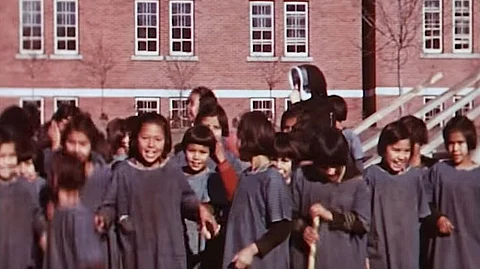

Parks Canada on Wednesday designated the Kamloops, BC Indian Residential School a national historic site — but omitted all reference to alleged graves in a nearby field, per Blacklock’s Reporter.
Claims in 2021 by the Tk’emlups te Secwepemc First Nation that it discovered 215 children’s graves on the schoolgrounds prompted an international outcry.
No remains were ever recovered.
“The Kamloops Indian Residential School was the largest institution in a system designed to carry out what the Truth and Reconciliation Commission described as cultural genocide,” Parks Canada said in a statement. It made no mention of unmarked burial sites. No reason was given.
The First Nation applied for the designation. Kamloops is the fifth former residential school to be listed as a national historic site along with institutions in Lestock, SK, Portage la Prairie, MB, Sault Ste. Marie, ON, Saint-Marc-de-Figuery, QC, and Shubenacadie, NS.
“A national historic site is considered for designation based on a place’s direct association with a nationally significant aspect of the history of Canada,” Parks Canada earlier told Blacklock’s.
“A number of residential schools have been designated as national historic sites to commemorate the history and legacy of the residential school system. The possibility of unmarked burials is not a determining factor for designation of any site.”
Prime Minister Justin Trudeau visited Kamloops in 2021 to “pay my respects to the graves,” he said at the time.
“That’s the realization that Canadians have taken on following the leadership right here in Tk’emlups, a discovery in May of 215 Indigenous kids in the graves just up the hill.”
The First Nation later revised its claim of 215 graves to 200 “potential burials.” Access To Information records show Tk’emlups received at least $12.1 million for field work, exhumation of remains, forensic research and DNA testing. Funds were instead spent on publicists, consultants and other expenses directly unrelated to recovery of any graves.
Investigators to date have been unable to corroborate claims of large numbers of unmarked burials at residential schools.
The 2015 Truth and Reconciliation Commission estimated 4,100 children died, a figure contradicted by coroners’ reports cited by the Senate Indigenous Peoples Committee in a 2024 report Missing Children, Missing Records.
The Kamloops school operated from 1890 to 1978 and in postwar years was the “largest Residential School in Canada,” according to a former Department of Aboriginal Affairs memo.
“There were approximately 15 buildings” including classrooms, dormitories, a sawmill, industrial school “and a swimming pool,” it said.
